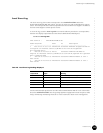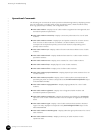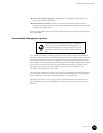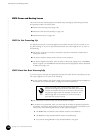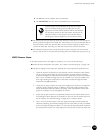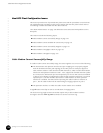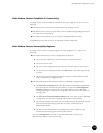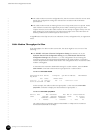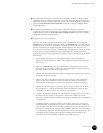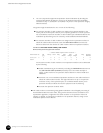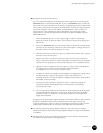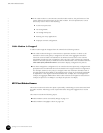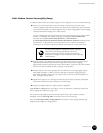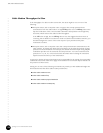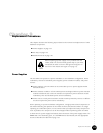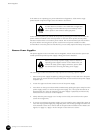
•
•
•
•
•
•
•
•
•
•
•
•
•
•
•
•
•
•
•
•
•
•
•
•
•
•
•
•
•
•
•
•
•
•
•
•
•
•
•
•
•
•
•
•
•
•
•
•
•
•
•
•
•
•
•
•
•
•
Troubleshooting
Ideal HFC Plant Configuration Issues
153
! The cable modem belongs to a downstream or upstream interface on which a traffic
scheduling policy is assigned. Packets that exceed the maximum sustained traffic rate
(MSTR) are dropped or shaped, depending on the traffic scheduling policy configuration.
Issue the show cable policy traffic-scheduling command to display configured traffic
scheduling policies.
! The cable modem belongs to a downstream or upstream interface on which a
congestion control policy is assigned, such as random early detection (RED), leading to
dropped packets. Issue the show cable policy congestion-control command to display
configured congestion control policies.
! Congestion exists in the upstream.
You can compute the approximate upstream channel utilization by monitoring the
ifInOctets object in the DOCS-IF-MIB (RFC 2670). The ifInOctets object contains the total
number of octets received on an interface, including data packets as well as MAC layer
packets, and includes the length of the MAC header. However, this object does not
account for the PHY layer overhead—preamble, FEC, and guard time—which consumes
a certain percent of the available raw channel bandwidth. The following procedure
explains how to compute the approximate upstream channel utilization using an SNMP
MIB browser:
1. Set the SNMP polling time to a value large enough to capture a statistically
significant amount of upstream traffic. In this example, assume the polling time is
60 seconds.
2. Browse the ifInOctets object for the interface that corresponds to the upstream
interface you are measuring. Wait for the value of the object to change and record
this value. Assume the value is 33,019,041 octets.
3. Wait 60 seconds for the value of the object to change and record this value. Assume
the value is 65,903,162 octets.
4. Subtract the value of the object measured in step 2 from the value measured in
step 3 to obtain the number of octets received by the CMTS on this upstream
interface over the polling time: (65,903,162–33,019,041=32,884,121 octets).
5. Multiply the value computed in step 4 by eight (to convert to bits), then divide by
the polling time to compute the upstream channel bandwidth (without the PHY
overhead): [(32,884,121 octets * 8) / 60 sec]=4,384,549 bps.
6. Compute the maximum available raw bandwidth by multiplying the symbol rate of
the channel by the number of bits/symbol. Assume the symbol rate is 2560
Ksym/sec, and the modulation is QPSK (2 bits/symbol), which yields a bandwidth of
5,120,000 bps.
7. Computing the PHY overhead, and hence the channel efficiency, is a non-trivial
exercise because it is dependent on the mix of transmissions that use a particular
interval usage code, packet sizes, and the modulation profile and mini-slot size of
the channel. Using practical values for these variables, assume a channel efficiency
of 92 percent (be aware that the channel efficiency can be lower depending on the
assumptions made). Derating the maximum available raw bandwidth of the
channel by 92 percent yields 4,710,400 bps (5,120,000 bps*0.92).



